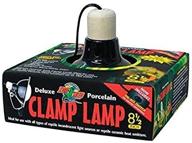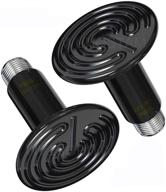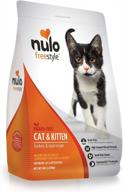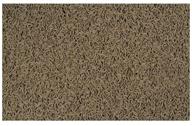
Review on 🦎 Zacro Reptile Heat Pad: Adjustable Under Tank Heater for 30-40gal Tank with Thermostat – Ideal for Turtles, Snakes, Lizards, Frogs, Spiders, and Plants! by Julia White

Safe and effective when used correctly. It has a 1/4 turn dimmer, no thermostat.
I understand why people have trouble burning these things. I'm about to graduate with a mechanical engineering degree, so I'm a bit well-versed in the physics of heat transfer. This thermal mat has a design flaw common to most thermal mats in that the heating elements tend to float in an air gap pocket that acts as an insulator. This prevents heat from being transferred to what you are trying to heat and the remaining heat will cause the heating element to overheat. The ideal solution would be to vacuum the bag and then inject some coolant into it, but there are easier ways to get around this. Just make sure there is enough weight on top to push the air out and that the object conducts heat well into your case, then due to its low power output there's no chance of it catching fire. The first rule of thumb with any type of heating element is to assume that the thermostat will fail because it will eventually fail. So make sure the application can handle continuous power output at rated power without catastrophic consequences. People who suggest placing them under the aquarium only make matters worse. The frame creates a large air gap under the aquarium, which acts as additional insulation. This prevents heat transfer to the glass. Gap ventilation can help prevent the heating mat from catching fire, but it also prevents it from doing what it's supposed to do - heating up the case. To use them effectively and safely, you need to insulate the bottom to prevent heat from spreading the wrong way and make sure the top is in direct contact with something that conducts heat well. One way to achieve this in a dry environment is to bury it in the sand inside the tank and put a piece of foam insulation in the gap under the tank to maximize heat retention, and then use a thermostat to gently regulate the temperature and increase slowly. Sand does not have the best thermal conductivity, but it is better than the layer of air and has a high heat capacity, which means that it warms up gradually and retains heat well. You need to give it time to stabilize after making adjustments. If it's a large enough enclosure, the animals can simply migrate to the other side if it gets too hot, but if the enclosure is small, an external thermostat with a probe inserted into the substrate is a safer option. If you think it might get wet you can place it under the aquarium pane, but be sure to put a piece of heat resistant foam insulation underneath so the heating mat fits snugly against the pane with no air gap. This is the only effective way to use it outside of the aquarium. I sandwiched it in a 40 gallon aquarium between a piece of cardboard for insulator and some concrete blocks with two egg cartons on top of the blocks. The Dubia cockroaches turned it into a hotel in a hurry and are now breeding like crazy. It's in my attic, which is usually around the 50's. The tank is surrounded by cardboard for insulation and blackout. I turn the thermostat to full throttle and the temperature in the brick hotel fluctuates between 80 and 85 degrees, depending on how warm it is in the attic. If it overheats on a warm day, they can just switch to the other side of the tank as the power isn't high enough to overheat the entire tank even in the height of summer. I may use an external thermostat or lower the temp on the built in next summer but so far so good. Update: I checked the power consumption to see if it has a real thermostat or dimmer. It turns out that this is not a thermostat, but a triac dimmer built into the cable. The knob rotates 3/4 from off to up. The first 1/2 turn does nothing. The last 1/4 turn adjusts the output power from 0W to 18W up and 9W about 1/8 turn up. Of course, if you don't have a wattmeter or ammeter, it's difficult to get reproducible settings.
- Nice packaging
- Can't remember
New products
Comments (0)
Top products in 🌡️ Terrarium Heat Lamps & Mats

Enhanced Lighting Solution: Zoo Med Deluxe Porcelain Clamp Lamp for Reptiles

10 Review

YLXD50YL LED Yeelight Halo Ceiling Light YLXD50YL, 52 W, color: white

10 Review

Outdoor Pet Heating Pads For Dog,Soft Electric Blanket Auto Temperature Control,Heated Mat For Dog House,Whelping Supply For Pregnant New Born Stray Feral Cat Puppy,Safe

19 Review

ETL Listed 2 Pack Wuhostam 100W Infrared Ceramic Heat Lamp, Black Reptile Emitter Bulb for Pet Coop Heater, Chicken, Lizard, Turtle, Brooder, Aquarium, Snake - No Harm, No Light

9 Review
Another interesting products

Premium Chihuahua Adult Dog Food In 3 Oz Cans From Royal Canin

30 Review

6-Pack Of Royal Canin Adult Instinctive Thin Slices In Gravy Wet Cat Food, 3 Oz. - Highly Digestible And Palatable Diet

28 Review

Give Your Feline Friends The Best With Nulo Freestyle Cat & Kitten Food - A Premium Grain-Free Dry Small Bite Kibble With High Animal-Based Protein And BC30 Probiotic For Optimal Digestive Health

21 Review

Dry food for reptiles Tetra ReptoMin Sticks, 250 ml, 60 g

16 Review

